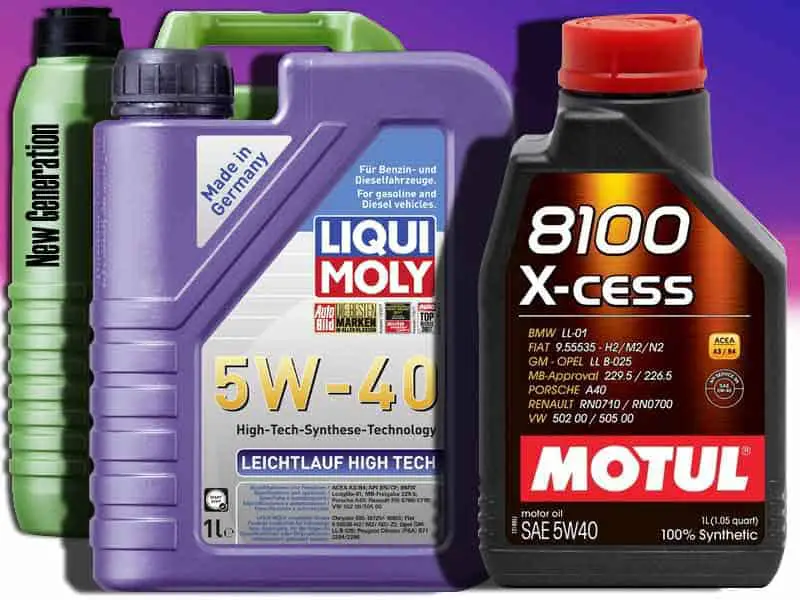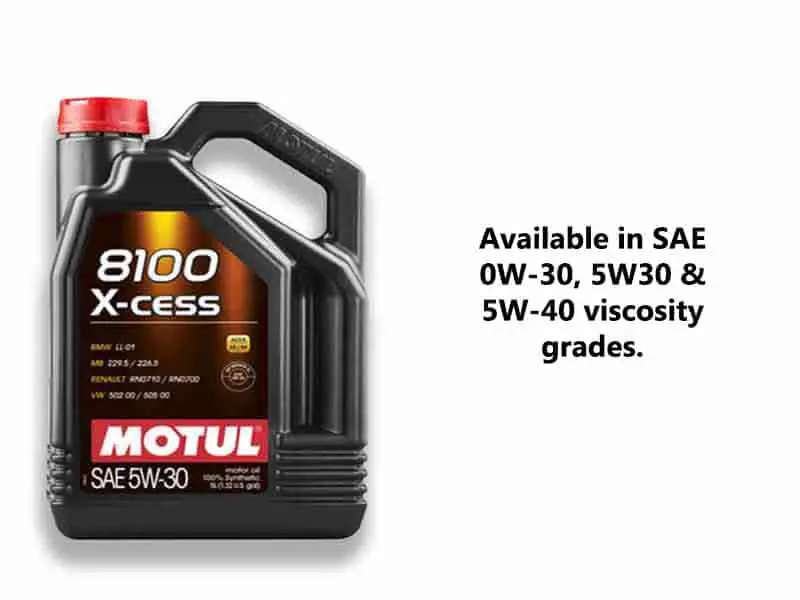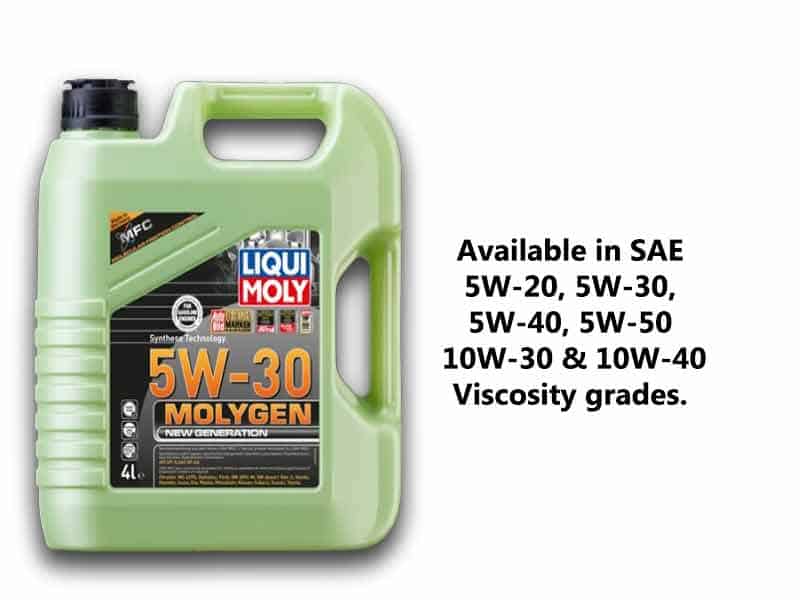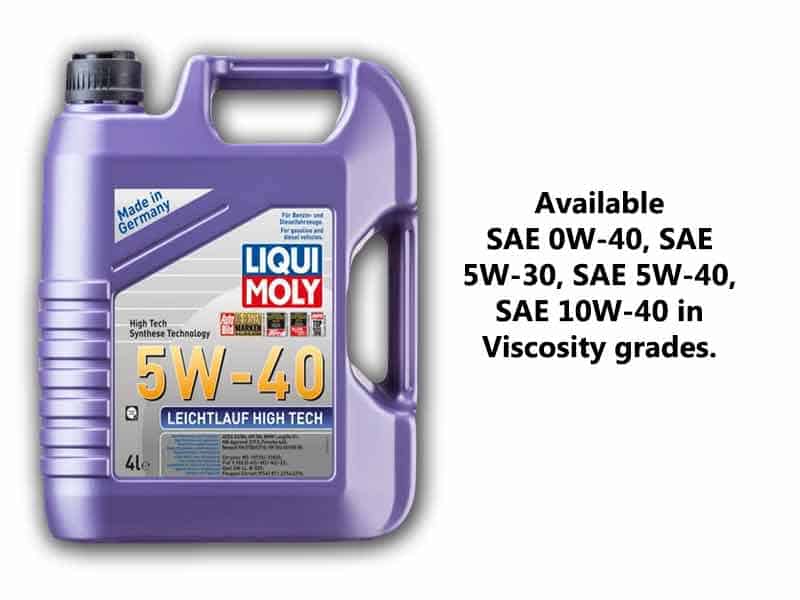We are comparing Liqui Moly Molygen New Generation and Leichtlauf with the famous Motul 8100 X-cess. And all of the contenders are fully synthetic motor oils manufactured from the group IV base oil and innovative oil additives. And they meet API SN and ILSAC GF-5 standards which signify that they provide improved fuel economy, emission control system compatibility, and sludge control.
Liqui Moly Molygen New Generation extends the engine’s life by controlling deposit formation, providing better wear protection, and reducing friction with the help of MFC (Molecular Friction Control). It is also compatible with catalytic converters and turbochargers. It is mixable with all commercially available engine oils.

Liqui Moly Leichtlauf High Tech is specially formulated for hot and cold conditions. It provides quick lubrication in the cold start and provides ideal pressure under all operating conditions. It is usually recommended for long oil change intervals even up to 40,000 km. Its sludge cleaning and wear protection ability is also phenomenal.
Motul 8100 X-cess is explicitly designed for powerful and modern cars equipped with gasoline and diesel engines. It is also suitable for LPG (Liquefied Petroleum Gas), biofuel, and ethanol. It has the best lubricating properties due to higher number of anti-wear additives added into it.
Table of Contents
Liqui Moly Vs Motul 8100
| Specifications | Liqui Moly Molygen New Generation | Liqui Moly Leichtlauf High Tech | Motul 8100 X-Cess |
| Oil Type | Full Synthetic | Full Synthetic | Full Synthetic |
| Engine Type | Gasoline / Diesel | Gasoline / Diesel | Gasoline/Diesel |
| Available viscosity grades | SAE 5W – 20, SAE 5W – 30, SAE 5W – 40, SAE 5W – 50, SAE 10W – 30, SAE 10W – 40 | SAE 0W – 40, SAE 5W – 30, SAE 5W – 40, SAE 10W – 40 | SAE 0W – 30, SAE 5W – 30, SAE 5W – 40 |
| ILSAC | GF-5 | GF-5 | GF-5 |
| API | SN | SN | SN |
| Oil change interval | 8,000 to 10,000 km | 8,000 to 10,000 km | 8,000 to 10,000 km |
| Additives | Anti-wear additives, Cleaning agents, Molygen additive, Friction modifiers | Anti-wear additives, Cleaning agents, extreme pressure additives, viscosity improvers | Anti-wear additives, Cleaning dispersants, and detergents |
| ACEA | A3/B4 | A3/B4 | A3/B4 |
Viscosity Comparison
Kinematic viscosity is the resistance of a fluid to flow, at a certain temperature, divided by its density. The kinematic viscosity trend of the contenders is Molygen > Motul > High Tech. This means that Molygen will be thicker than its competitors at a certain temperature.

Viscosity index shows the effect of temperature change on the viscosity of any lubricant. The lower the viscosity index, the higher the effect will be. We can clearly say that Molygen would be affected the most by temperature change. Motul would be affected lesser than Molygen and High Tech will be least affected by temperature change than its competitors.

The flow characteristics of any lubricant depend upon its pour point. It is the temperature below which a liquid loses its flowing capability. Motul will seize to flow in cold weather before its competitors. After that, Molygen would lose its flowing ability. The best option in the cold weather conditions is High Tech because its pour point temperature is lower than its competitors.

| Parameter | Liqui Moly Molygen New Generation 5w-40 | Liqui Moly Leichtlauf High Tech 5w-40 | Motul 8100 X-cess 5w-40 |
| Kinematic Viscosity at 40o C | 90cSt | 70 | 85.4 |
| Kinematic Viscosity at 100o C | 14.5 cSt | 12.9 | 14.2 |
| Viscosity Index | 170 | 190 | 172 |
| Pour Point | -39o C | -45 | -36 |
Oil Change Frequency Comparison
Alkaline-based additives are added to engine oils to neutralize acids, which come into existence due to oxidation, combustion, and many other reactions that occur inside an engine. The neutralizing ability of these additives depends upon the Total Base Number (TBN).
By observing the tested data given below, we can state the fact that Molygen would be able to neutralize acids for more time than its competitors since it has the highest value of TBN. Hence its oil change frequency would be lower than other contenders. High Tech would have higher oil-changing frequency than Molygen but lower than Motul. The least favorable option here would be Motul since its TBN is the lowest than of all competitors.
| Parameter | Liqui Moly Molygen New Generation 5w-40 | Liqui Moly Leichtlauf High Tech 5w-40 | Motul 8100 X-cess 5w-40 |
| Total Base Number | 9.9 mg KOH/g | 9.4 mg KOH/g | 9.2 mg KOH/g |
Catalytic Converter Performance
Two major anti-wear additives, zinc and phosphorous, affect the performance of catalytic converter as they burn and turn into ash, poisoning the catalytic convertor. The quantity of these anti-wear additives in engine oil is directly proportional to the formation of ash and hence impact on the catalytic converter.
By the tested result of virgin oil given below, we can conclude that Motul is the least safe option since its zinc and phosphorous concentrations are higher than its competitors. The other two contenders seem to have approximately the same amount of anti-wear additives in them and would be preferred in this regard.
| Engine Oil | Concentration of Zinc (ppm) | Concentration of Phosphorous (ppm) |
| Liqui Moly Molygen New Generation 5w-40 | 877 | 823 |
| Liqui Moly Leichtlauf High Tech 5w-40 | 896 | 799 |
| Motul 8100 X-cess 5w-40 | 980 | 890 |
Reduction of Sludge build
Due to overheating and exposure to moisture, engine oil goes through a process of breakdown and combines with dirt, water molecules, and contamination. It produces sludge and deposit in the engine which can affect the flow of engine oil. That’s why engine oil manufacturers add sludge cleaning detergents such as magnesium, sodium, and calcium in the oil.
By analyzing the tested data given below, it is obvious that Molygen is the best sludge cleaning engine oil among the three contenders. After that, we have High Tech in line and Motul is lacking in this regard than its competitors.
| Additive | Content in Liqui Moly Molygen New Generation 5w-40 (ppm) | Content in Liqui Moly Leichtlauf High Tech 5w-40 (ppm) | Content in Motul 8100 X-cess 5w-40 (ppm) |
| Magnesium | 10 | 10 | 16 |
| Sodium | 6 | 0 | 2 |
| Calcium | 2909 | 2778 | 2723 |
Oil Burn-off protection
Engine oil gets burned down when it is in high-temperature conditions. But which engine oil would burn quicker depends upon a very important parameter known as the flashpoint. It is the minimum temperature above which any lubricant’s vapors get burned if provided an ignition source.
By the tested result given below, we can say that Molygen would burn up before its competitors since its flash point is lower than the others. The other contenders would burn at the same pace since their flash point value is the same.
| Parameter | Liqui Moly Molygen New Generation 5w-40 | Liqui Moly Leichtlauf High Tech 5w-40 | Motul 8100 X-cess 5w-40 |
| Flash Point | 220o C | 232 o C | 232 o C |
Minimizing Engine Wear-Off
To protect the engine from wear and corrosion, anti-wear additives are being added to the engine oils. The most popular anti-wear additives are zinc, phosphorous, boron, and molybdenum. Their quantities in an engine oil will determine its wear protection ability.
Motul contains a high amount of anti-wear additives in it and hence it gains superiority in wear protection over its competitors. Among Molygen and High Tech, Molygen takes the lead making High Tech the least favorable option in this regard.
| Additive | Content in Liqui Moly Molygen New Generation 5w-40 (ppm) | Content in Liqui Moly Leichtlauf 5w-40 (ppm) | Content in Motul 8100 X-cess 5w-40 (ppm) |
| Zinc | 877 | 896 | 980 |
| Phosphorous | 823 | 799 | 890 |
| Boron | 2 | 0 | 68 |
| Molybdenum | 96 | 0 | 0 |
Summary
- All of the contenders are fully synthetic and made up of group IV base oil and innovative additives.
- Motul would create more zinc and phosphorous ash which will affect the performance of catalytic converters.
- Molygen has superiority over its competitors when it comes to cleaning sludge.
- Motul and High Tech are preferred in high-temperature conditions instead of Molygen.
- Motul provides better wear protection than its competitors.
- In cold weather conditions, High Tech is to be prioritized since it would sustain its flowing characteristic, in cold weather, better than its competitors.
- Oil change frequency trend is Motul > High Tech > Molygen, making Molygen the best choice in this regard.